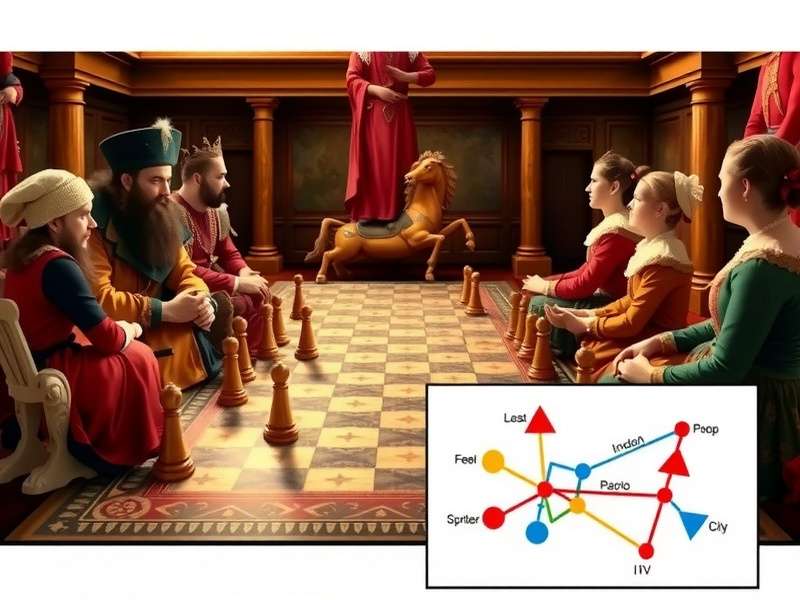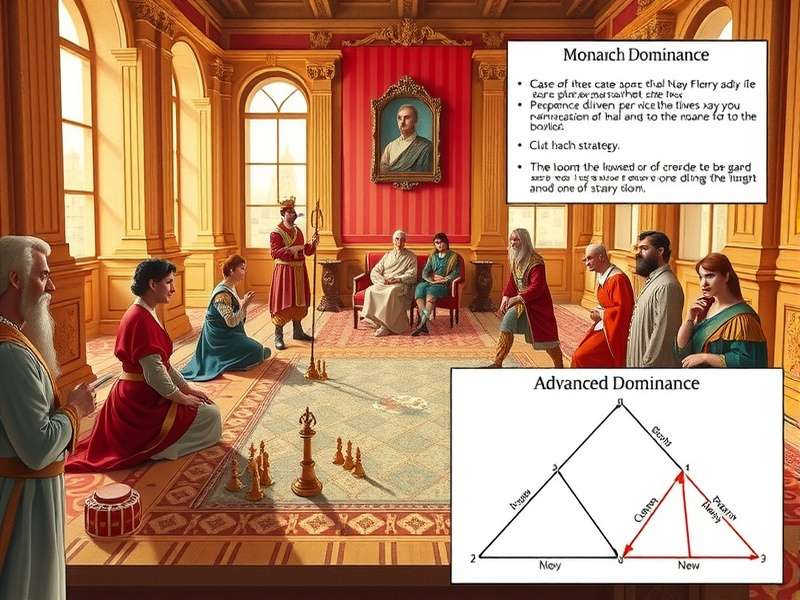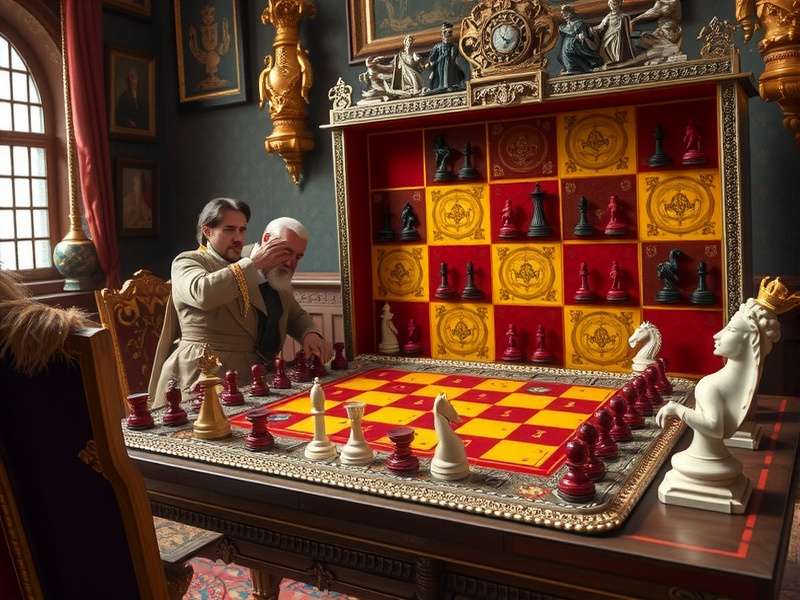Monarch Dominance: The Ultimate Indian Strategy Game 🏰
Discover the rich history, intricate rules, and winning strategies of Monarch Dominance - India's premier strategic board game of royal conquest.

📜 Game Overview
Monarch Dominanceis a traditional Indian strategy board game that simulates royal conquest and territorial expansion. With origins dating back centuries, this game has been played by royalty and commoners alike, testing strategic thinking and foresight.
The game represents a simplified model of medieval Indian warfare and diplomacy, where players take on the role of regional monarchs vying for control over the subcontinent. Each player commands unique pieces with special abilities, reflecting the diverse military traditions of historical Indian kingdoms.
Key Facts About Monarch Dominance
What setsMonarch Dominanceapart from other strategy games is its unique blend of deterministic movement and probabilistic outcomes, creating a gameplay experience that rewards both careful planning and adaptability to changing circumstances.
The game board features a symmetrical design with special territories that provide strategic advantages, encouraging players to balance offensive expansion with defensive consolidation. This creates dynamic gameplay where the tide of fortune can shift dramatically with a single well-executed maneuver.
📖 Historical Origins & Evolution
The earliest references toMonarch Dominanceappear in Sanskrit texts from the Gupta Empire period (circa 4th-6th centuries CE), where it was known as "Rājā Adhipatya" (Royal Supremacy). These texts describe a game played by nobility to teach military strategy and statecraft to young princes.
During the Mughal era, the game evolved significantly, incorporating elements from Persian and Central Asian strategy games. The Mughal emperors were known to be avid players, with Akbar the Great reportedly maintaining a court player who specialized in teaching the game to royal children.

The British colonial period sawMonarch Dominancedecline in popularity among the elite but it remained popular in rural areas and among certain communities. It was during this time that the game began to develop regional variations, with different rules emerging in various parts of the subcontinent.
In the post-independence era, efforts to standardize and preserve traditional Indian games led to the establishment of formal rules forMonarch Dominancein the 1970s. This revival movement helped the game regain popularity, and today it is recognized as an important part of India's cultural heritage.
Regional Variations
Across India's diverse regions,Monarch Dominancehas developed distinctive local characteristics. In South India, the game typically features additional pieces representing elephant corps, reflecting the historical military importance of war elephants in the region.
The Rajasthani version emphasizes cavalry movements and hit-and-run tactics, mirroring the martial traditions of the Rajput warriors. Meanwhile, the Bengali variation incorporates riverine territories that affect movement, acknowledging the geographical significance of rivers in the region.
⚖️ Official Rules & Gameplay
The standard version ofMonarch Dominanceis played on a 9x9 grid board with 81 intersections. Each player begins with 18 pieces of different types, representing various military units in a historical Indian army.
Game Components
A completeMonarch Dominanceset includes the game board, playing pieces in four colors (typically red, blue, green, and yellow), and sometimes specialty dice for certain advanced variants of the game.
- Raja (King):1 piece - moves one space in any direction
- Mantri (Minister):2 pieces - moves diagonally any number of spaces
- Gaja (Elephant):2 pieces - moves orthogonally any number of spaces
- Ashva (Horse):2 pieces - moves in L-shape like chess knight
- Ratha (Chariot):2 pieces - moves orthogonally any number of spaces
- Padati (Foot Soldier):9 pieces - moves forward one space, captures diagonally
- Dhanusha (Archer):2 pieces - moves like chariot but can "jump" over one piece
Setup & Objective
Players arrange their pieces on their respective sides of the board according to traditional starting positions. The primary objective is to checkmate the opponent's Raja while protecting your own. Secondary victory conditions include capturing a specific number of opponent pieces or controlling a majority of special territories.
Important Rule Variations
While standardized rules exist, many households and regions play with local variations. Tournament play typically uses the standardized rules established by the All India Traditional Games Federation in 1987, with minor updates in 2005 to balance gameplay.
Movement & Capturing
Players take turns moving one piece according to its movement capabilities. Capturing is done by displacement - moving your piece onto a square occupied by an opponent's piece. The captured piece is removed from the game. Special rules apply for the "fortress" squares located at the four corners and center of the board.
The Padati (foot soldier) has a unique promotion rule: when it reaches the opponent's back row, it is promoted to a Vir (Hero) piece, which moves like a Raja but with additional capturing abilities. This rule adds strategic depth to what might otherwise be considered the weakest piece in the game.
🎯 Advanced Strategies & Tactics
MasteringMonarch Dominancerequires understanding both fundamental principles and advanced strategic concepts. Successful players balance aggressive expansion with defensive positioning, knowing when to attack and when to consolidate their forces.
Strong openings inMonarch Dominancetypically involve controlling the center territories while developing multiple pieces simultaneously. Avoid moving the same piece repeatedly in the opening phase unless necessary.
Classic opening sequences include the "Lotus Deployment" where pieces fan out from the Raja in a circular pattern, and the "Vanguard Advance" which focuses on rapid forward development of foot soldiers supported by cavalry.
The midgame is characterized by piece exchanges and territorial battles. Look for "fork" opportunities where one piece threatens multiple opponent pieces simultaneously.
Effective midgame strategies include creating "passed padatis" (foot soldiers that have a clear path to promotion) and establishing control over the fortress squares, which provide defensive advantages and restrict opponent movement.
In the endgame, material advantage often determines the outcome. Learn basic checkmating patterns with limited pieces, particularly Raja and Mantri versus lone Raja.
King activity becomes crucial in endgames - centralize your Raja to both attack and defend. Understanding the concept of "opposition" (controlling key squares relative to the opponent's king) is essential for converting advantages into victories.
Beyond pure calculation,Monarch Dominanceinvolves psychological warfare. Learn to recognize your opponent's playing style and adapt accordingly.
Techniques like offering "poisoned pawns" (pieces that appear unprotected but lead to unfavorable positions if captured) can trap overly aggressive players. Similarly, creating complex positions can overwhelm opponents who struggle with calculation under time pressure.
Common Strategic Themes
Several recurring strategic themes appear in high-levelMonarch Dominanceplay. The "Pincer Attack" involves attacking from both wings simultaneously, stretching the opponent's defenses. The "Fortress Breach" focuses on overwhelming a single defensive strongpoint with concentrated force.
The "Trade Denial" strategy involves avoiding piece exchanges when ahead in development, maintaining complexity and initiative. Conversely, when facing a stronger position, simplifying the game through exchanges can be an effective equalizing strategy.

🌍 Cultural Significance & Modern Relevance
Monarch Dominanceholds a special place in Indian cultural heritage, representing not just entertainment but also philosophical concepts and historical memory. The game embodies principles of dharma (duty), artha (purpose), and karma (action) through its mechanics.
In many Indian families, learningMonarch Dominanceis a rite of passage, with grandparents teaching grandchildren the same strategies they learned in their youth. This intergenerational transmission has helped preserve the game through centuries of social change.
Educational Applications
Recognizing the cognitive benefits of strategic games, several Indian educational institutions have incorporatedMonarch Dominanceinto their curricula. Studies have shown that regular play improves problem-solving skills, pattern recognition, and strategic thinking in students.
The game is particularly effective for teaching mathematical concepts such as probability, combinatorics, and game theory. Its spatial elements also help develop geometric intuition and visualization skills.
Competitive Scene
Since the establishment of the National Monarch Dominance Championship in 1992, competitive play has grown steadily. The game now features regional qualifying tournaments leading to a national final held annually in New Delhi.
International interest has also increased, with players from Southeast Asia, Europe, and North America participating in invitational tournaments. Efforts are underway to haveMonarch Dominancerecognized as a demonstration sport in future international mind sports events.
Digital Adaptations
In recent years,Monarch Dominancehas found new life in digital formats. Mobile apps and online platforms allow players to compete across distances, while AI implementations have helped analyze and refine strategy.
These digital versions have introduced the game to younger generations and international audiences, ensuring that this traditional Indian strategy game continues to evolve while maintaining its cultural essence. The most popular app has been downloaded over 500,000 times, with active communities in over 50 countries.
Preservation Efforts
Cultural organizations across India are working to document regional variations ofMonarch Dominancebefore they are lost. The Ministry of Culture has recognized the game as an "Intangible Cultural Heritage" item, providing funding for workshops and documentation projects.
Museums in Kolkata, Mumbai, and Chennai feature permanent exhibits on traditional Indian games, withMonarch Dominanceoccupying a prominent position. These exhibits include historical game sets, instructional materials, and interactive displays that allow visitors to learn and play.
🔮 Future of Monarch Dominance
As we look to the future,Monarch Dominanceappears poised for continued growth and evolution. The game's inherent strategic depth ensures its lasting appeal, while modern adaptations make it accessible to new audiences.
Initiatives are underway to develop standardized teaching methods and certification for instructors, similar to systems used for chess and Go. This professionalization of instruction will help spread the game more systematically while maintaining quality standards.
Research into the cognitive benefits of playingMonarch Dominancecontinues, with preliminary studies suggesting it may have particular benefits for developing executive function in children and maintaining cognitive agility in older adults.
Whether played on traditional wooden boards or digital screens,Monarch Dominancecontinues to challenge minds and bring people together, preserving an important piece of Indian cultural heritage while adapting to the modern world.